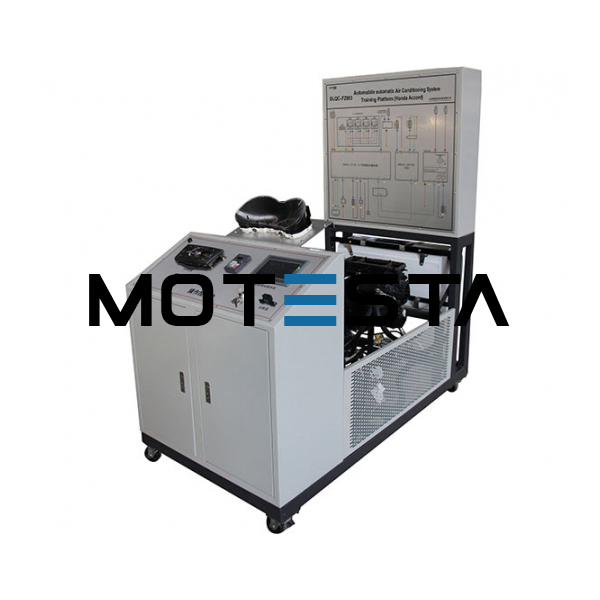 lab@motestainstruments.com | Civil and Mechanical Engineering Lab Equipments India China
lab@motestainstruments.com | Civil and Mechanical Engineering Lab Equipments India China

Code: TVET-ITI-1001242
Training Platform for Automobile Air Conditioning System.
Introduction to the Training Platform
This training board uses a Chevrolet Cruze model based on an entire
automatic A/C system that fully supports auxiliary systems. It
demonstrates the entire vehicle structure and operation, leading to its
wide usage in teaching electrical theory, practical operation, fault
diagnosis and other mechanical or engineering vehicle operations in the
higher, vocational colleges and training institutions.
Basic Configuration of the Training Platform
Frequency converter
Three-phase asynchronous motor
Ignition switch
A/C switch
Diagnosis socket
High low pressure pipeline
A/C pressure switch
Cold and hot damper conversion motor
Face damper actuator motor
Middle damper actuator motor
Foot damper actuator motor
Heater
Refrigerant pressure sensor
Sunshine sensor
Environment temperature sensor
Outlet temperature sensor
Intake temperature sensor
Evaporation box temperature sensor
Room temperature sensor
Automatic A/C control unit
Dryer assembly
Expansion valve
Condensator
Evaporator
Heater
Measurement plate and movable bracket
Supporting manual
Training guide book
Features of the Training Platform for Automobile Air Conditioning System
1. Speed control motor as the power source, properly working automatic
A/C system, which operates in a steady manner and shows the entire
structure and working principle of the A/C system.
2. The bench plate is assembled with a high/low pressure gauge to directly show pressure changes in the refrigeration pipe.
3. An assembled digital indicator gauge shows the related sensors’ static value and dynamic value.
4. The training bench is equipped with automatic A/C system color
schematics and detection terminals. The element signal parameter of A/C
system, such as voltage, resistance, frequency, and other parameters can
be detected using special instruments.
5. The training bench is equipped with diagnostic blocks and can be
connected to a dedicated or universal car decoder for reading the entire
vehicle’s electrical fault codes, clear fault codes, read data stream,
actuate components test, parameter settings, waveform analysis, and
other self-diagnostic functions.
6. Fault setting and appraisal system: use the fault setting box set
manually or delete single and combination faults, including all the
sensors, actuators and controller faults. Fault setting types:
disconnection, short circuit, and virtual connection- turn the fault
switch to the original position, and the fault is deleted. Users can set
any recombination fault and delete the original fault. Using concealed
fault settings is convenient for student testing, and the instructor can
set various hard emulation faults in the sensors and controlling unit
(example: magnetic, thermosensitive, pressure-sensitive, photoelectric,
and electromagnetic). The fault type is signal distortion or accidental
fault.
7. The training board is assembled with a protection cover.
8. A mobile device with locking casters moves freely to better facilitate teaching.
Training Content
1. Automatic A/C system structure and working principle training
2. The students can carry out vacuuming, injecting refrigerant, and fault checking training
3. Automatic A/C system elements assembled position training
4. Automatic A/C system elements voltage, resistance, signal and refrigerant pressure measurement training
5. Automatic A/C system refrigeration and heating principle analyzing training
6. Controlling unit DTC (diagnostic trouble code) reading, DTC
elimination, data flow reading, guard against theft matching adjustment,
programming, terminal element detecting training
7. Automatic A/C system fault diagnosis and elimination training
8. Automatic A/C system operation and theory examination training
Technique Features of the Training Platform
1. Auto type: Chevrolet Cruze (custom-made)
2. Input power: AC 380V±10% 50Hz; 220V±10% 50Hz (single phase)
3. Working power: DC12V
4. Three phase asynchronous motor
type:Y100L1-2
voltage:AC 380V
power:2.2KW
current:5.0A
rotary speed:1430r/min
5. Working environment temperature: -40℃~+50℃
6. Dimensions: 1600×850×1800mm
7. The bracket is welded using high quality material and powder coating.